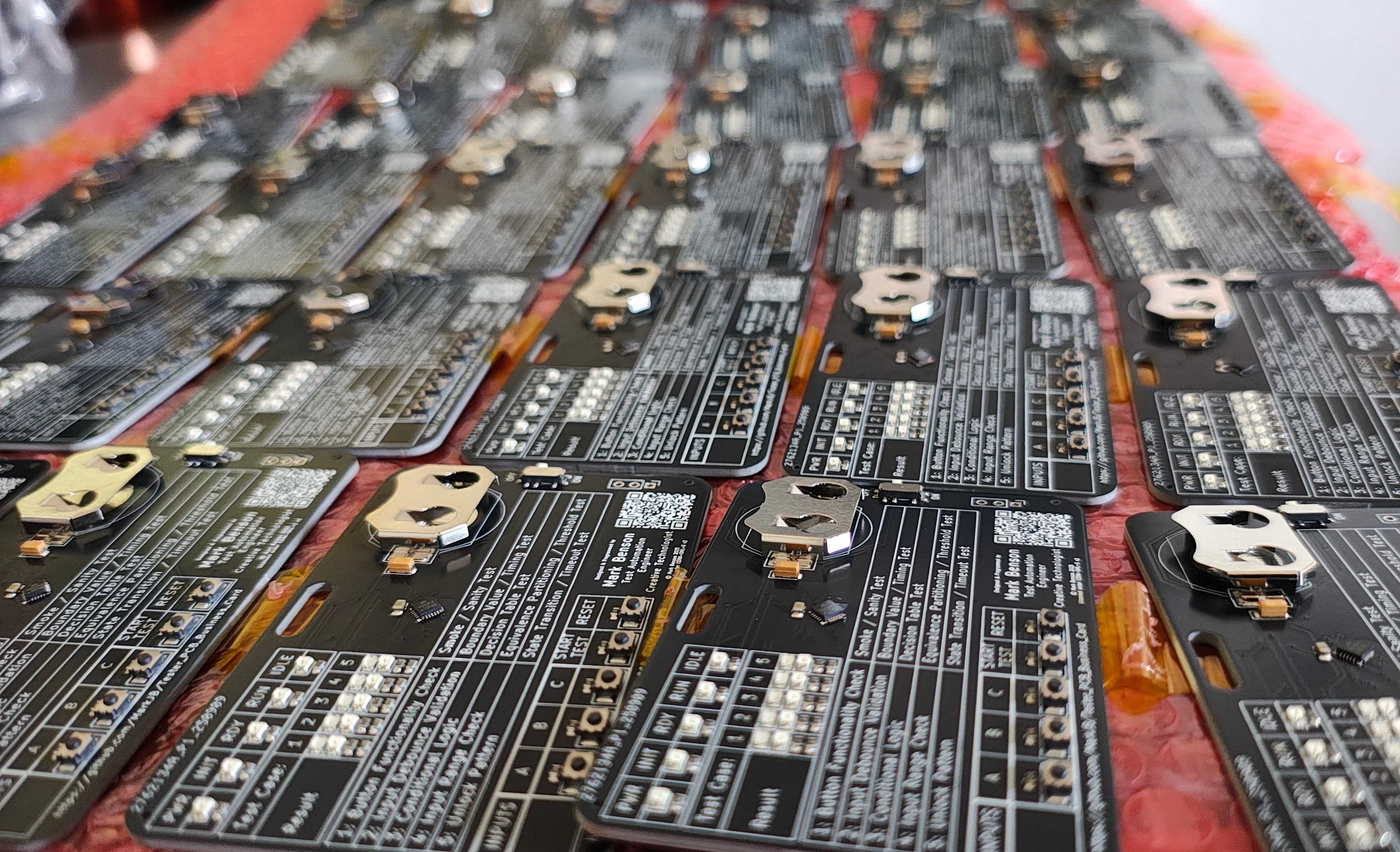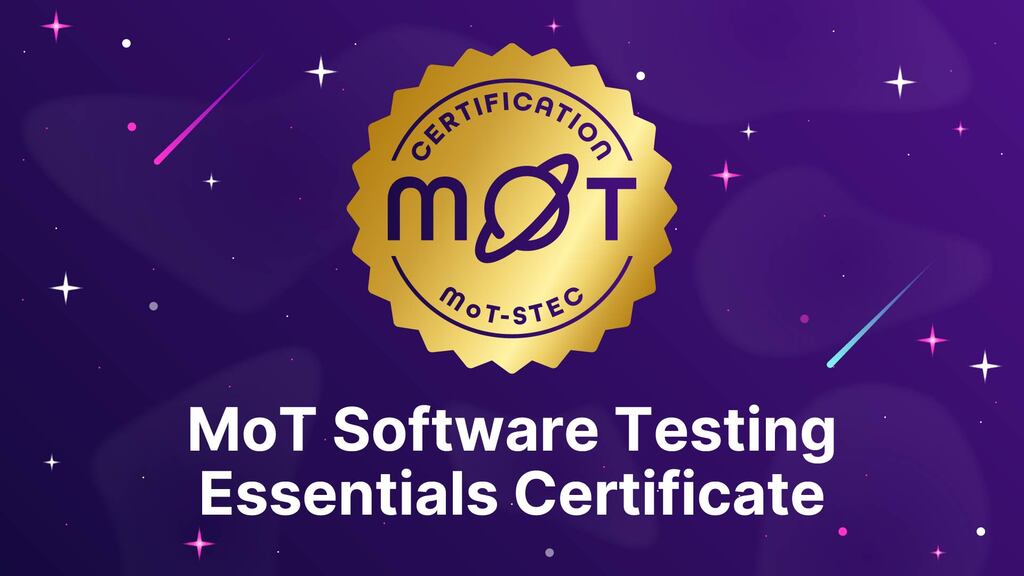
I wanted to share some details about the PCB Business Card that I gave away while at TestBash/MoTaCon 2025.
I should probably add some context... What was it? It was a tester puzzle in a business card format. 5 tests, 3 test inputs and only a few hints on how to make them pass. Why did I do it? I like making and tinkering with microcontrollers for fun and I've always wanted to make a PCB business card (they are a thing in the hardware/hacker/maker world). But also I wanted something memorable that would be an interesting conversation starter.
Given that I was trying to do this on a shoestring budget while job hunting. I opted to stay on a campsite a mile and a bit away from the venue to save on accommodation which saved me ~£150. So that gave me my budget for creating these cards. I can't thank everyone at the Ministry of Testing enough for sponsoring my place this year. I'm hoping to attend again next year 🤞
The card was designed with open source PCB design package KiCad and the initial PCB run of 5 boards from JLCPCB cost about $6 and the components from their sister company LCSC, cost ~$23 (including a debugger/programmer for CH32 series microcontrollers) . I generally order a few boards to make sure my designs work... software mistakes are easy to fix, hardware mistakes, not so much. I hand soldered 2 boards to test and to develop against, and once I was happy that everything was correct, I ordered a small batch prototype production run from JLCPCB. But not before adding some Ministry of Testing graphics to the back!
Having spent about £22 so far, I was able to order 50 boards, fully assembled with shipping and taxes for $151 (~£115) making each card cost $3 (~£2.25) if I ignore R&D 😁.
Then I had to buy 50 batteries which cost £10 taking the cost per card to ~£2.45 each. At some point I thought it would be a good idea to add a slot so I could wear the card like a conference badge, and for some reason I decided to buy 50 lanyards as well... thinking others might want to wear the card in the same way, but early on I realised that was just a bit weird (why would someone else want to wear my business card!) so I ditched that idea. Thankfully the lanyards were surplus from eBay and only added another £7 to the total so I'm not counting that 😁
Can we talk about the CH32V003 microcontroller for a second... 27 cents (~21p) for a 48MHz 32bit RISC processor with 2K RAM, 16K FLASH and18 IO pins is mind-blowing! Also $9 for a hardware level debugger/programmer is awesome! I could step through the code, inspect registers and variables on the hardware right in VSCode!
As for actually designing the things, I probably spent about 3 days on the circuit schematic and 2 days on the PCB design (auto routing the connections saved me a good chunk of time here). Normally this kind of thing takes me a few weeks of evenings, reading data sheets and considering trade offs for component choice and how to connect things up, what libraries exist and what peripherals are available and of course, IO pin count. This time I leaned heavily on AI to speed up that process plus I had the luxury of being able to work on this like a full time job. Adding in time to re-evaluate when I got to the ordering process and the components I had settled on were no longer in stock, so I had to pivot or redesign a part of the board (changing a footprint here or there or figuring out if the available components would still work).
The firmware probably took another 5 days to complete, again leaning heavily on AI made this faster. Normally it would take me a week or two to read and digest the docs and get something up and running, but thankfully AI knew enough about the framework I was using to make quick progress. I hit a few road blocks, where I trusted the AI a little too much that it knew what it was talking about when manipulating registers, so I lost a couple of days trying to track down an issue with Interrupt Service Routines (ISR). I wrote a few "test" firmware, one to check the inputs and outputs were working as expected. This came in very handy for the boards I hand assembled as the components were tiny (the microcontroller is 3mm square and has 20 pins that I can barely see) and my soldering wasn't great. It was also handy for highlighting that the push buttons didn't take well to cleaning with IPA... any ingress seemed to make the buttons not work reliably. Another firmware was used to tune or turn down the LED brightness - I used this firmware to turn on some of the LEDs so I could try different resistor values to those calculated during the design phase.
I also used AI to very quickly spin up a web based simulator between ordering the PCBs and them turning up. It took about a day to create and I used it to test the user experience of the test cases on the hardware before I actually had any hardware. You can play with the simulator as its running on GitHub here: https://markjb.github.io/Tester_PCB_Business_Card/
After completing the firmware on the prototype boards, I was able to program all 50 cards in about 30 mins.
Over the course of the weekend I gave away 46 cards. About half on the first day and half on the second. I honestly thought I'd given them all away but missed one pack of 4... I shipped one to someone I didn't catch up with on the Sunday so I have a few to add to my collection of PCBs I've made over the years.
All in all, I gave away 47 cards. Each one involved at least one conversation often turning into a group chat. While I was expecting nothing in return other than a conversation, I received some swag including a Katalon T-Shirt, a case to keep the cards in and a few offers of beer (thanks all! You know who you are 😁)!
From the feedback received since, I know at least one person has successfully made all the tests pass and discovered the Easter egg (though perhaps not the full significance of it yet)
https://github.com/MarkJB/Tester_PCB_Business_Card






